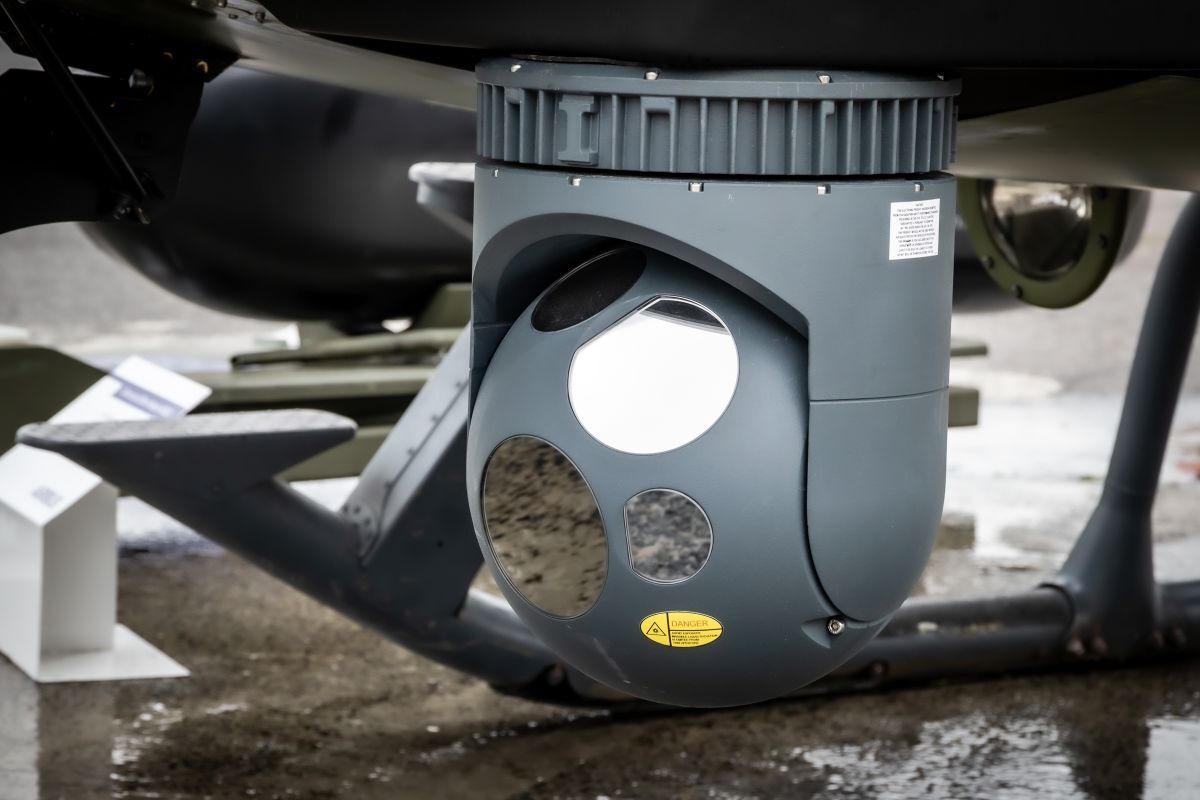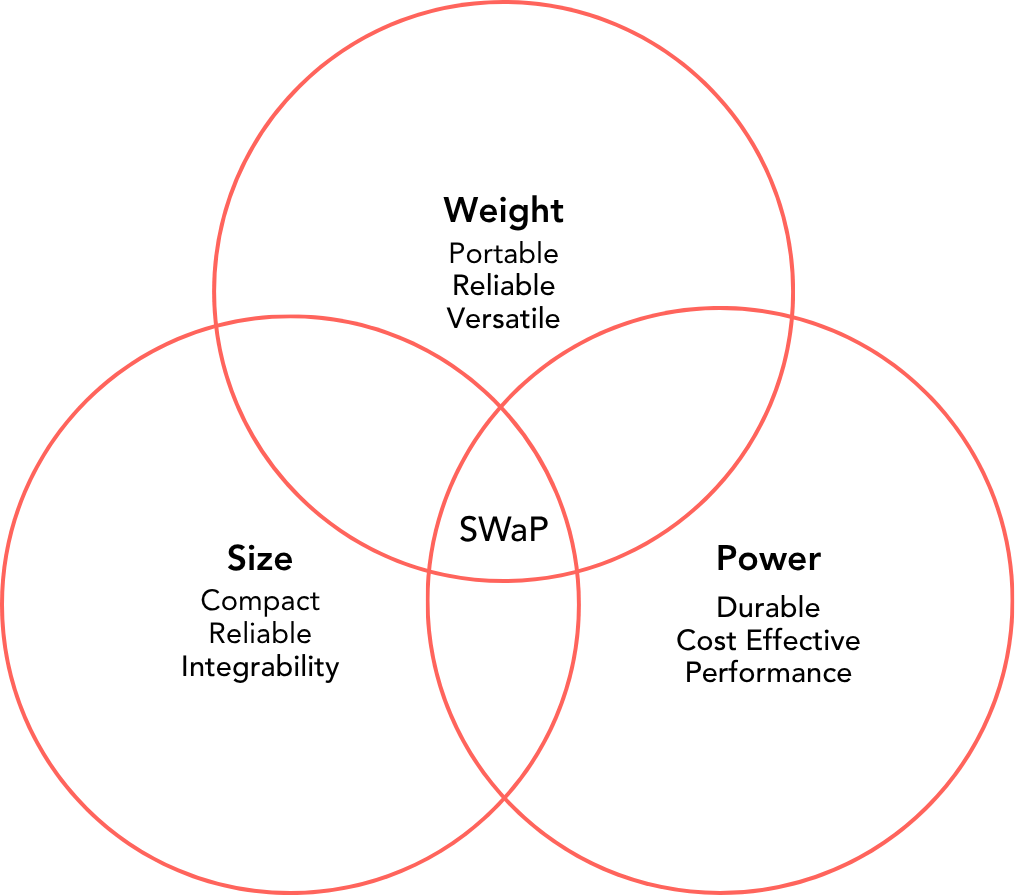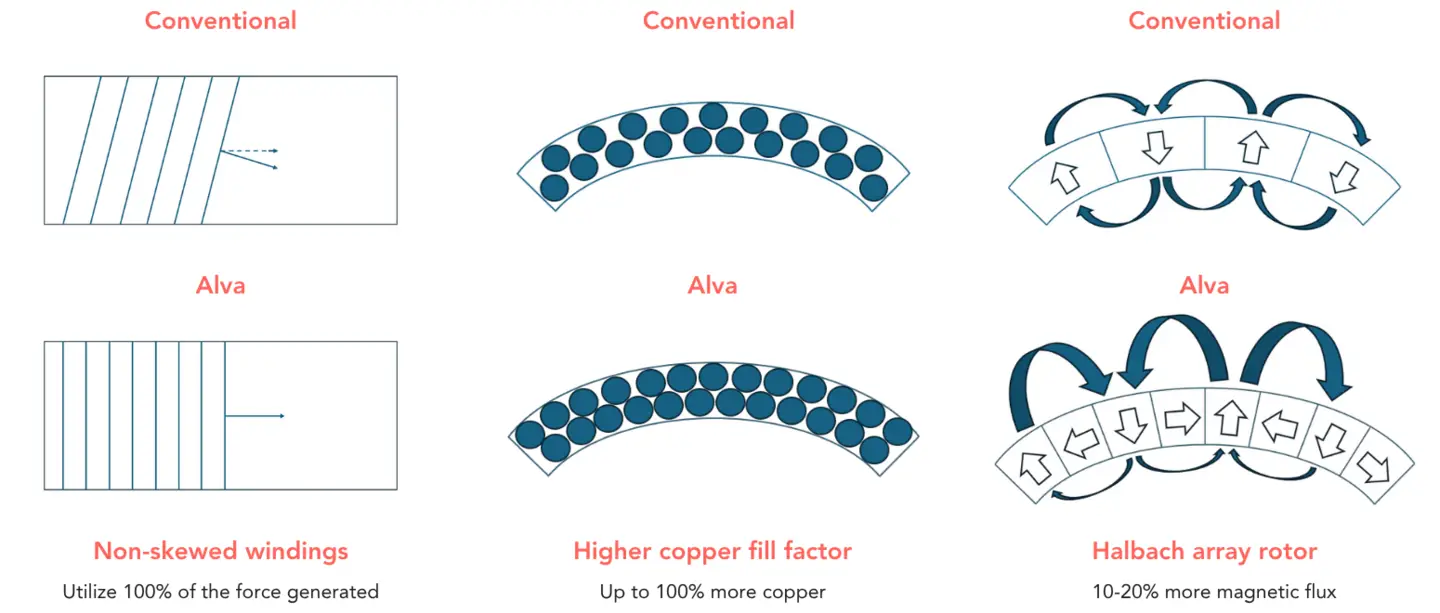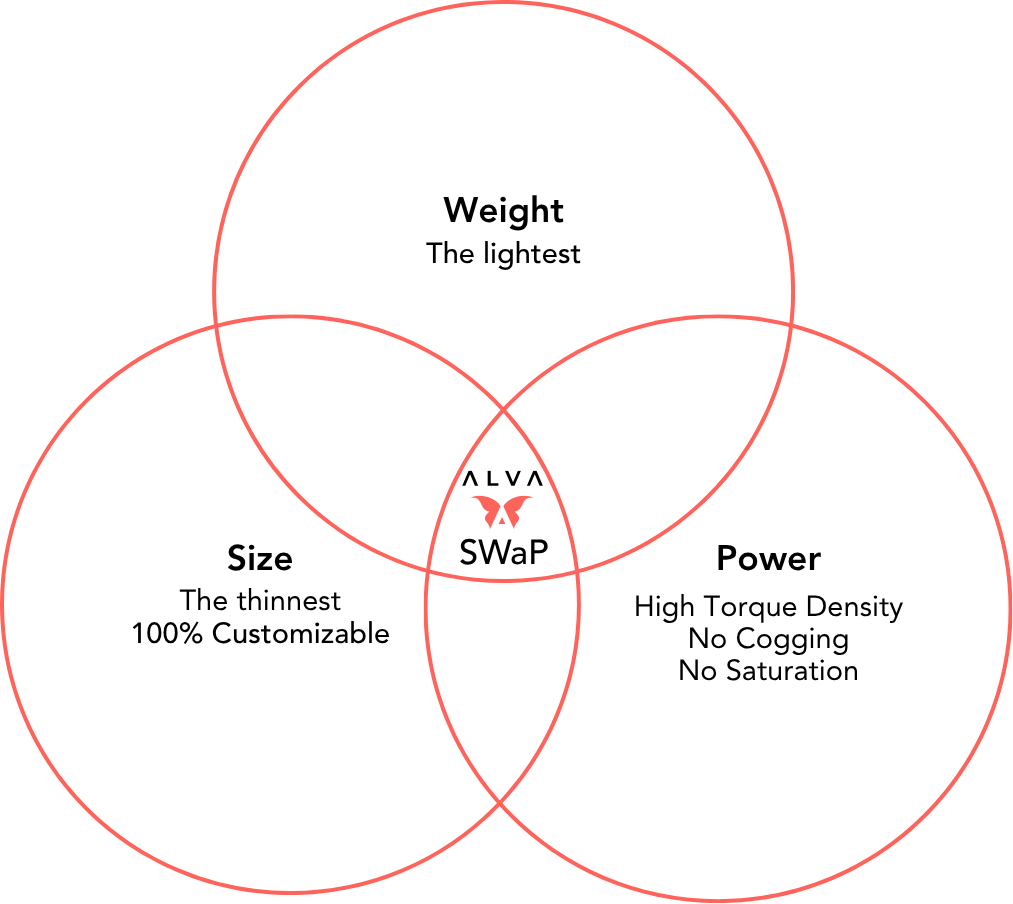SWaP Optimization in Gimbal Systems
Advanced FiberPrinted™ slotless motor technology addresses size, weight, and power optimization challenges in modern aerospace and defense gimbal systems.
July 29, 2025

Introduction
Modern aerospace and defense gimbals, frequently deployed on Unmanned Aerial Vehicles (UAVs), Unmanned Ground Vehicles (UGVs), aircrafts, and demanding defense platforms, are facing strict requirements for minimal Size, Weight, and Power (SWaP) while simultaneously achieving high precision and dynamic performance. This article dives into how advanced motor technologies improve performance, followed by a deeper dive into FiberPrinted™ slotless torque motors and their impact on SWaP in demanding gimbal and stabilization systems.
SWaP as an Imperative in Modern Gimbal Systems
The relentless drive for enhanced operational capabilities, extended mission durations, and reduced logistical footprints makes SWaP optimization paramount in gimbal designs. Key criteria for high-performance gimbal systems among other things include:
Small Size & Low Weight: Motors must fit into very compact housings and minimize the added mass to the vehicle, especially if airborne systems are considered. Small, lightweight motors enable smaller payload frames and longer endurance of the aircraft, especially considering UAVs. Designers often seek the thinnest and lightest motors for integration into gimbal systems.
Low Power Consumption & High Efficiency: Available power is often limited on airborne platforms due to battery limitations. Motors must operate efficiently over the required speed/torque range, minimizing losses and ensuring effective heat dissipation. A high electrical efficiency extends battery life and improves the performance of the entire system.

Here's why SWaP is so important, Figure 1 summarizes the following section:
Improved portability:
Gimbals are often integrated into optronic systems, sensors, and other payloads that demand high dynamic performance. In these applications, portability and compactness are critical, not only to reduce total system weight, but also to enable integration into constrained spaces, such as UAVs or handheld platforms.
Enhanced energy efficiency:
Carriers of gimbal systems are battery powered, and even non-battery-powered systems often face strict energy constraints. Thus, a reduced power consumption allows for longer operating times on a single charge or tank of fuel, which is a key factor in assessing platform viability across use cases and deployment scenarios.
Increased reliability:
Improvements in size, weight, and power (SWaP) result in smaller, lighter components, and in some cases, even a reduced number of components. This combination leads to increased system reliability: lower mass reduces susceptibility to vibrations and shocks, while fewer components mean fewer potential points of failure.
Cost-effectiveness:
Just like energy efficiency, improvements in SWaP can reduce overall system costs, making gimbals more accessible to a wider range of users and enabling more versatile deployment across platforms.
Better integration:
Reducing the size of the gimbal allows engineers to make better use of the limited available space. This reduction can also enable more efficient integration with other onboard systems such as cameras, sensors, and communication devices.
Improved performance:
Performance is a broad concept, but if we focus on the most important aspect for stabilization systems, performance would be just that, stabilization. By minimizing the size and weight of the gimbal itself, more resources can be dedicated to the core stabilization, resulting in smoother, more precise movements.

Trade-offs and compromises on design improvement
Meeting the competing demands of SWaP, dynamic performance, rotational inertia, and cost requires careful engineering trade-offs. In an ideal world, gimbals could be large, expensive, and optimized for only one aspect of performance, but real-world constraints require balanced solutions. Gimbals must not only meet technical specifications, but also fit within budget, size, and integration requirements. Designing for performance is only part of the challenge; designing for manufacturability, affordability, and usability is equally essential.
Beside SWaP, what else is important for Gimbal systems?
High-bandwidth torque control:
Short rise times are required to quickly track commands or disturbances. Mechanics with low inertia and low electrical time constants provide faster acceleration and more efficient moving behaviours.
High Precision:
For jitter-free pointing or smoothest scanning, cogging and torque ripple must be as low as possible. Even small detent torques degrade image stability and quality, especially noticeable at low speeds. Low cogging solutions, with high precision encoders, combined with high precision bearings are a good start into addressing this need.
High acceleration:
Similar to short response time, but not quite the same, gimbals are strongly requesting highest acceleration of an optical device or sensor to be integrated in the subassembly (payload). In case of Direct Drive approaches, this is commonly resolved with high torque motors.
Thermal stability:
Among one of the most relevant aspects related to measurements and precision pointing is the thermal stability of the system. Even when most gimbals will have a compensation (software) for temperature, avoiding that sensors get very hot or very cold is also important to achieve high accuracy results.
Many of the mechanical challenges of designing a Gimbal were already discussed in an earlier article: https://www.alvaindustries.com/post/drive-systems-in-precision-gimbals
Therefore, this article will focus mainly on the motor selection in order to improve the SWaP optimization:
To improve Size, Weight, and Power (SWaP) through motor selection, several key factors must be considered when choosing a motor for a gimbal system:
- High Torque Density: for higher torque output, lower weight and reduced power consumption
- Large Through-Hole: for overall size reduction
- Low Cogging & Low Torque Ripple: for more precise motion (faster targeting, less errors)
- Low Inductance: for short response times
Understanding most used Motor Technologies for Gimbals:
All kinds of technologies are used in the development of Gimbal systems.
The so-called Gimbal Motors, can be housed and frameless, slotted and slotless, combined with a gear or gearless (Direct Drive).
The advantages of frameless compared to framed motors for Gimbal systems, that require a high SWaP, are many. Frameless motors enable a tighter mechanical integration that saves space, weight and ultimately will require less power (due to the reduction in mass and inertia).
Similar story with the geared and direct drive discussion, although not for every situation a general statement can be found, sometimes geared solutions will be better for SWaP optimization (especially big systems).
Finally, the technology of the motor will have a strong influence on the final design. Torque motors can be divided into two main categories Slotted and Slotless. Another article dives much deeper into this topic: https://www.alvaindustries.com/post/slotless-motors-vs-slotted-motors
Slotted motor topology
Slotted or iron core motors consist of a stator with laminated steel teeth and winding slots, paired with a rotor that typically includes permanent magnets. The slots of the stator are guiding the copper windings, ensuring high magnetic coupling and torque density. These motors operate based on electromagnetic induction, where current through the stator windings generates a rotating magnetic field that drives the rotor.
Due to the presence of slots, slotted motors exhibit a high and recognizable cogging torque, which provides holding torque at zero speed and causes high torque ripple during the motion profile. This makes them suitable for applications where high torque, robustness, and efficiency are critical but are not great for precision applications.
Slotless motor topology
Slotless or ironless motors feature a stator without iron slots, using instead a smooth, cylindrical stator bore where the windings are embedded in a self-supporting structure, often made of resin or epoxy. The rotor, typically equipped with high-performance permanent magnets, rotates within this slotless stator.
This architecture eliminates cogging torque entirely, resulting in exceptionally smooth and precise rotation, especially at low speeds. Additionally, the absence of slots reduces magnetic losses and minimizes torque ripple, making slotless motors ideal for high-precision applications where low noise, minimal vibration, and superior dynamic response are essential, such as in gimbals, medical devices, optics, robotics, and aerospace systems. Slotless motors are typically less powerful than a slotted motor, due to skewed windings and low coper-fill factor.
.webp)
FiberPrinted™ Motor Technology and Innovation Aspects
SlimTorq™ motors from Alva Industries embody these advantages of both motor topologies with none of the disadvantages, offering a different approach to make slotless motors through the unique manufacturing process and optimized motor architecture. This several times patented FiberPrinting™ technology is an automated process that achieves an exceptionally high copper fill factor of up to 60%.

This is directly correlated to significant performance improvements and hence torque density, greater compactness, and higher efficiency compared to traditional motor designs. Coupled with non-skewed windings (allowing 100% utilization of generative force) and a highly efficient Halbach-array rotor (providing 10-20% more magnetic flux), the SlimTorq motor series delivers an ultimate combination of precision, torque density and lightest weight ensuring the highest compactness.

Key SWaP-Optimizing Features and Benefits from SlimTorq™
FiberPrinted™ motors inherently align with and address the core SWaP challenges in gimbals:
- Exceptional Size and Weight Reduction: the thinnest and lightest in the market
- Unparalleled Precision and Smooth Control: cogging free, extremely low torque ripple (<1%)
- High Efficiency: very low speed dependent losses and high peak torques
- High Bandwidth and Zero Backlash: Low Inductance and Direct Drive capability
- Mechanical Robustness & Customization: FiberPrinting™ allows for full new designs in less than an hour.
The pursuit of optimal SWaP parameters is fundamentally transforming gimbal design. FiberPrinted slotless motors, with their radical innovations in manufacturing and motor architecture, represent a significant step forward.
By delivering ultra-compact, lightweight, highly efficient, and zero-cogging torque solutions with extensive customization options, this technology is directly enabling the next generation of high-performance gimbals.
Too much text and not enough data? Do you want to learn how SlimTorq™ compares to others? Take a look at our whitepaper: https://www.alvaindustries.com/papers-downloads/lite-white-paper-fiberprinted-tm-motors-for-high-precision-swap-gimbals

All rights reserved ©2025